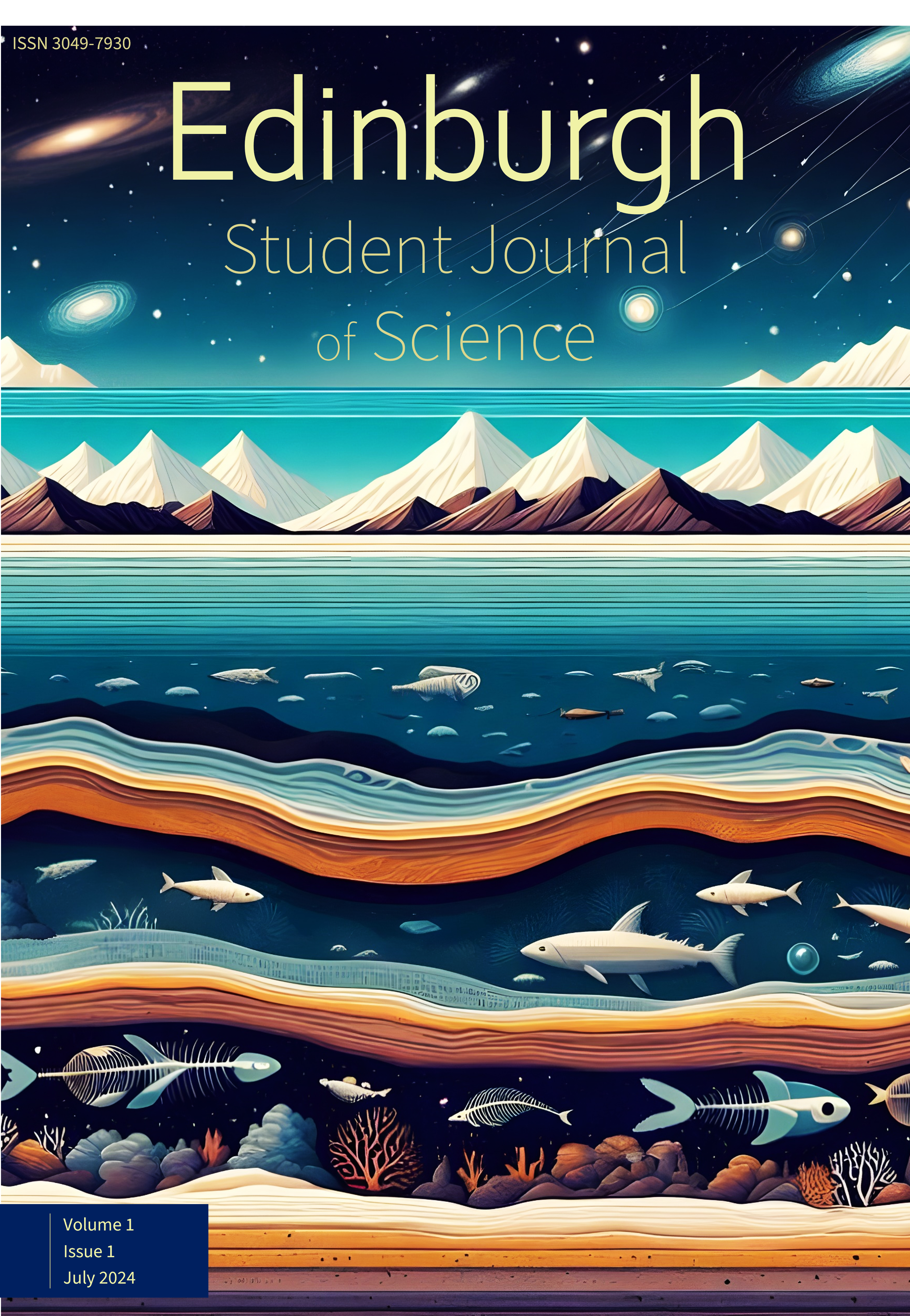Assessing the Reliability of Early Marine Cements in Recording Changes in Seawater Redox Conditions Across the Late-Devonian Mass Extinction
DOI:
https://doi.org/10.2218/esjs.9681Keywords:
Late Devonian Mass Extinction, Marine AnoxiaAbstract
The Late-Devonian Mass Extinction (LDME) extinguished up to 40% of all marine species, with evidence suggesting marine anoxia was the primary cause. This study performs rare earth element analysis of early marine cements from reefal limestones from Australia and Scotland to show that these cements capture a marine anoxic signature across the LDME for the first time, directly implicating marine anoxia and by extension, the rise of land plants, as the cause of the LDME. This work also demonstrates that early marine cements serve as reliable proxies for recording changes in seawater redox conditions over whole-rock analysis.
Downloads
References
Algeo, T. J. et al. ‘Late Devonian Oceanic Anoxic Events and Biotic Crises: ‘Rooted’ in the Evolution of Vascular Land Plants’ GSA Today 5 3 (1995)
Algeo, T. J. and Scheckler, S. E. ‘Terrestrial-Marine Teleconnections in the Devonian: Links Between the Evolution of Land Plants, Weathering Processes, and Marine Anoxic Events’ Philosophical Transactions of the Royal Society of London. Series B: Biological Sciences 353 1365 (1998)
Banner, J. L. et al. ‘Rare Earth Element and Nd Isotopic Variations in Regionally Extensive Dolomites From the Burlington-Keokuk Formation (Mississippian); Implications for REE Mobility During Carbonate Diagenesis’ Journal of Sedimentary Research 58 3 (1988)
Buggisch, W. ‘Zur Geologie Und Geochemie Der Kellwasserkalke Und Ihrer Begleitenden Sedimente (Unteres Oberdevon)’ (Wiesbaden; 1972)
Dahl, T. W. et al. ‘Devonian Rise in Atmospheric Oxygen Correlated to the Radiations of Terrestrial Plants and Large Predatory Fish’ Proceedings of the National Academy of Sciences 107 42 (2010)
Edwards, D. et al. ‘Could Land-Based Early Photosynthesizing Ecosystems Have Bioengineered the Planet in Mid-palaeozoic Times?’ Palaeontology 58 5 (2015)
Franchi, F. et al. ‘Trace Elements and REE Geochemistry of Middle Devonian Carbonate Mounds (Maïder Basin, Eastern Anti-atlas, Morocco): Implications for Early Diagenetic Processes’ Sedimentary Geology 343 (2016)
German, C. R. and Elderfield, H. ‘Application of the Ce Anomaly as a Paleoredox Indicator: The Ground Rules’ Paleoceanography 5 5 (1990)
Kabanov, P. et al. ‘Oceanic Anoxic Events, Marine Photic-Zone Euxinia, and Controversy of Sea-Level Fluctuations During the Middle-Late Devonian’ Earth-Science Reviews 241 (2023)
Kalvoda, J. et al. ‘Fine-Scale LA-ICP-MS Study of Redox Oscillations and REEY Cycling During the Latest Devonian Hangenberg Crisis (Moravian Karst, Czech Republic)’ Palaeogeography, Palaeoclimatology, Palaeoecology 493 (2018)
Ma, X. P. et al. ‘Facies and Geochemistry Across the Early-Middle Frasnian Transition (Late Devonian) on South China Carbonate Shelf: Comparison With the Polish Reference Succession’ Palaeogeography, Palaeoclimatology, Palaeoecology 269 3 (2008)
Martin-Garin, B. and Montaggioni, L. F. ‘The Highs and Lows of the Reef Phenomenon’ in Corals and Reefs: From the Beginning to an Uncertain Future (Springer International Publishing; 2023)
McGhee, G. R. and Racki, G ‘Extinction: Late Devonian Mass Extinction’ (Wiley; 2021)
Nothdurft, L. D. et al. ‘Rare Earth Element Geochemistry of Late Devonian Reefal Carbonates, Canning Basin, Western Australia: Confirmation of a Seawater REE Proxy in Ancient Limestones’ Geochimica et Cosmochimica Acta 68 2 (2004)
Poty, E et al. ‘Bio- and Sequence Stratigraphic Correlations Between Western Europe and South China: To a Global Model of the Eustatic Variations During the Mississippian’ in Programme and Abstracts: The XVII International Congress on the Carboniferous and Permian (Geological Survey of Western Australia; 2011)
Racki, G. ‘Big 5 Mass Extinctions’ in Encyclopedia of Geology (Elsevier; 2021)
Raup, D. M. and Sepkoski, J. J. ‘Mass Extinctions in the Marine Fossil Record’ Science 215 4539 (1982)
Stanley, S. M. ‘Estimates of the Magnitudes of Major Marine Mass Extinctions in Earth History’ Proceedings of the National Academy of Sciences 113 42 (2016)
Tostevin, R. et al. ‘Effective Use of Cerium Anomalies as a Redox Proxy in Carbonate-Dominated Marine Settings’ Chemical Geology 438 (2016)
Wallace, M. W. et al. ‘Oxygenation History of the Neoproterozoic to Early Phanerozoic and the Rise of Land Plants’ Earth and Planetary Science Letters 466 (2017)
Webb, G. E. and Kamber, B. S. ‘Rare Earth Elements in Holocene Reefal Microbialites: A New Shallow Seawater Proxy’ Geochimica et Cosmochimica Acta 64 9 (2000)
Wood, R. ‘Palaeoecology of a Post-extinction Reef: Famennian (Late Devonian) of the Canning Basin, North-Western Australia’ Palaeontology 47 2 (2004)
Xiong, Y. et al. ‘The Record of Sea Water Chemistry Evolution During the Ediacaran-Cambrian From Early Marine Cements’ The Depositional Record 9 3 (2023)
Yao, L. et al. ‘The TICE Event: Perturbation of Carbon-Nitrogen Cycles During the Mid-tournaisian (Early Carboniferous) Greenhouse-Icehouse Transition’ Chemical Geology 401 (2015)
Zeng, J. et al. ‘Hydrothermal Activities and Seawater Acidification in the Late Devonian FF Transition: Evidence From Geochemistry of Rare Earth Elements’ Science China Earth Sciences 54 4 (2011)
Downloads
Published
Issue
Section
License
Copyright (c) 2024 Craig Mellon, Rachel Wood, Laetitia Pichevin

This work is licensed under a Creative Commons Attribution 4.0 International License.




